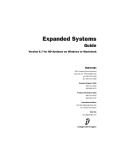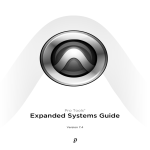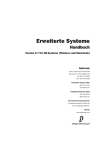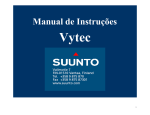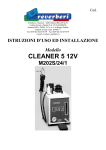Download Magma P13R Product specifications
Transcript
3&,([SDQVLRQ6\VWHP 8VHU V0DQXDO 35356HULHV 9918 Via Pasar San Diego, CA 92126 Phone (858) 530-2511 Fax (858) 530-2733 www.magma.com [email protected] [email protected] Copyright © 2002 MAGMA This publication is protected by Federal Copyright Law, with all rights reserved. No part of this publication may be copied, photocopied, reproduced, stored in a retrieval system, translated, transmitted or transcribed, in any form or by any means manual, electric, electronic, electro-magnetic, mechanical, optical or otherwise, in whole or in part without prior written consent from MAGMA. Limitation of Liability Information presented by MAGMA in this manual is believed to be accurate and reliable. However, MAGMA assumes no responsibility for its use. No license is granted by implication or otherwise to any rights of MAGMA. Product specifications and prices are subject to change without notice. Trademark References Trademarks and registered trademarks are proprietary to their respective manufacturers. 0$*0$ 7DEOHRI&RQWHQWV PREFACE III Advisories iii Safety Instructions iv When Working Inside a Computer Protecting Against Electrostatic Discharge Regulatory Compliance Statements FCC Class A Notice CE Certification Safety Standards vii vii vii vii Declaration of Conformity viii Quality & Service ix Product Warranty 30 Day Money Back Guarantee Free Technical Assistance Warranty & Repair in Seven Days Returns for Repair/Replacement/Credit Out of Warranty Repair Advanced Replacement Service CHAPTER 1 iv v INTRODUCTION ix ix ix ix ix x x 1 The 7 & 13 Slot Rack-mount PCI Expansion System 1 Pre-Installation Information 1 Parts List 2 7 Slot Rack-mount PCI Expansion System: 13 Slot Rack-mount PCI Expansion System: 2 2 Tools Required for Installation 3 CHAPTER 2 4 QUICK START GUIDE Step One: Remove PCI Expansion System Cover 4 Step Two: Install PCI Expansion Interface Card 4 Step Three: Power Down Host Computer and Remove Cover 5 Step Four: Remove PCI Cards from Host Computer 5 Step Five: Install PCI Host Interface Card 5 Step Six: Install PCI Cards in PCI Expansion System 6 Step Seven: Attach PCI Expansion Cable(s) 7 Step Eight: Recheck Installation 8 Step Nine: Power Sequence 8 3535 6HULHV 8VHU V 0DQXDO L 0$*0$ Powering Up: Powering Down: 8 9 Step Ten: System Should Be Up and Running 9 Step Eleven: Finishing Touches 9 CHAPTER 3 BUS HIERARCHY Bus Hierarchy CHAPTER 4 11 11 ADVANCED INSTALLATION GUIDE 13 Installation Notes 13 Multiple PCI Expansion System Configurations 13 Daisy-Chaining Fan-Out 13 14 PCI Card Conflicts 15 Console Firmware Issues 15 CHAPTER 5 17 HOW TO GET MORE HELP Contacting Technical Support 17 Frequently Asked Questions 17 Returning Merchandise to MAGMA 17 APPENDIX A 19 MAC OS VERIFICATION MagmaSlots 19 APPENDIX B DIGIDESIGN® PRO TOOLS 21 APPENDIX C PCI-BASED SUN WORKSTATION GUIDE 22 Introduction 22 Requirements 22 Installation 22 Sample Configuration 22 LL 3535 6HULHV 8VHU V 0DQXDO 0$*0$ 3UHIDFH Advisories Three types of advisories are used throughout this manual to provide helpful information or to alert you to the potential for hardware damage or personal injury. They are Notes, Cautions, and Warnings. The following is an example of each type of advisory. Use caution when servicing any electrical component. NOTE An amplifying or explanatory comment related to procedural steps or text. CAUTION Used to indicate and prevent the following procedure or step from causing damage to the equipment. WARNING Used to indicate and prevent the following step from causing injury. Disclaimer: We have tried to identify all situations that may pose a warning or caution condition in this manual. However, MAGMA does not claim to have covered all situations that might require the use of a Caution or Warning. 3535 6HULHV 8VHU V 0DQXDO LL L 0$*0$ Safety Instructions Before handling the MAGMA PCI Expansion System, read the following instructions and safety guidelines to prevent damage to the product and to ensure your own personal safety. Refer to the “Advisories” section for advisory conventions used in this manual, including the distinction between Warnings, Cautions, and Notes. ♦ Always use caution when handling/operating the computer. Only qualified, experienced, authorized electronics personnel should access the interior of the computer. The power supplies produce high voltages and energy hazards, which can cause bodily harm. ♦ Use extreme caution when installing or removing components. Unplug the power cord before removing the cover. The cover can only be opened by persons having appropriate technical training and experience necessary to be aware of hazards to which they are exposed in performing a task and of measures to minimize the danger to themselves or other persons. Refer to the installation instructions in this manual for precautions and procedures. WARNING High voltages are present inside the chassis when the unit’s power cord is plugged into and electrical outlet. Disconnect the power cord from its source before removing the chassis cover. Turning off the power switch does not remove power to components. Never modify or remove the radio frequency interference shielding from your workstation or expansion unit. To do so may cause your installation to produce emissions that could interfere with other electronic equipment in the area of your system. When Working Inside a Computer Before taking covers off a computer, perform the following steps: Y LY L 1. Turn off the computer and any peripherals 2. Disconnect the computer and peripherals from their power sources to prevent electric shock or system board damage. 3. Follow the guidelines provided in “Regulatory Compliance Statements” on the following page. 4. Disconnect any telephone or telecommunications lines from the computer. 3535 6HULHV 8VHU V 0DQXDO 0$*0$ In addition, take note of these safety guidelines when appropriate: ♦ To help avoid possible damage to systems boards, wait five seconds after turning off the computer before removing a component, removing a system board, or disconnecting a peripheral device from the computer. ♦ When you disconnect a cable, pull on its connector or on its strain-relief loop, not on the cable itself. Some cables have a connector with locking tabs. If you are disconnecting this type of cable, press in on the locking tabs before disconnecting the cable. As you pull connectors apart, keep them evenly aligned to avoid bending any connector pins. Also, before connecting a cable, make sure both connectors are correctly oriented and aligned. CAUTION Do not attempt to service the system yourself except as explained in this manual. Follow installation instructions closely. . Protecting Against Electrostatic Discharge Electrostatic Discharge (ESD) Warning Electrostatic Discharge (ESD) is the enemy of semiconductor devices. You should always take precautions to eliminate any electrostatic charge from your body and clothing before touching any semiconductor device or card by using an electrostatic wrist strap and/or rubber mat. Static electricity can harm system boards. Perform service at an ESD workstation and follow proper ESD procedure to reduce the risk of damage to components. MAGMA strongly encourages you to follow proper ESD procedure, which can include wrist straps and smocks, when servicing equipment. You can also take the following steps to prevent damage from electrostatic discharge (ESD): ♦ When unpacking a static-sensitive component from its shipping carton, do not remove the component’s anti-static packaging material until you are ready to install the component in a computer. Just before unwrapping the anti-static packaging, be sure you are at an ESD workstation or grounded. 3535 6HULHV 8VHU V 0DQXDO ; 0$*0$ ;YLL ♦ When transporting a sensitive component, first place it in an anti-static container or packaging. ♦ Handle all sensitive components at an ESD workstation. possible, use anti-static floor pads and workbench pads. ♦ Handle components and boards with care. Don’t touch the components or contacts on a board. Hold a board by its edges or by it’s metal mounting bracket. 3535 6HULHV 8VHU V 0DQXDO If 0$*0$ Regulatory Compliance Statements This section provides the FCC compliance statement for Class A devices and describes how to keep the system CE complaint. The Following Information is Required by the FCC FCC Class A Notice If your system is FCC Class A, the following applies: Note - This equipment has been tested and found to comply with the limits for a Class A digital device, pursuant to Part 15 of the FCC Rules. These limits are designed to provide reasonable protection against harmful interference when the equipment is operated in a commercial environment. This equipment generates, uses and can radiate radio frequency energy and, if not installed and used in accordance with the instruction manual, may cause harmful interference in which case the user will be required to correct the interference at his own expense. This device complies with Part 15 of the FCC Rules. Operation is subject to the following two conditions: (1) this device may not cause harmful interference, and (2) this device must accept any interference received including interference that may cause undesired operation. Changes or modifications not expressly approved by the party responsible for compliance could void the user’s authority to operate the equipment. NOTE The assembler of a personal computer system may be required to test the system and/or make necessary modifications if a system is found to cause harmful interferences or to be noncompliant with the appropriate standards for its intended use. CE Certification The product(s) described in this manual complies with all applicable European Union (CE) directives. For computer systems to remain CE complaint, only CE-complaint parts may be used. Maintaining CE compliance also requires proper cable and cabling techniques. MAGMA will not retest or recertify systems or components that have been reconfigured by customers. Safety Standards The products(s) described in this manual has met the safety requirement of Underwriters Laboratories (UL) for the US and Canadian market based on UL’s published Standards for Safety. 3535 6HULHV 8VHU V 0DQXDO ;YLL LL 0$*0$ Declaration of Conformity Manufacturer’s Name: Manufacturer’s Address: MAGMA, Inc. A Mobility Electronics, Inc., Company 9918 Via Pasar San Diego, CA 92126 USA Declares that the product: Computer Peripheral Equipment Type of Equipment: Product Name: MAGMA PCI Expansion System P7R, P7RC1.5, P7RQ, P7RQC1.5, P7R-D1, P7RC1.5Model Number: D1, P7RQ-D1, P7RQC1.5-D1, P7R-IFA, P7RC1.5-IFA, P7R64, P7R64C1.5, P7RQ64, P7RQ64C1.5, P7R464C1.5, P7R464C1.5, P7R464-D1, P7R464C1.5D1, P13R, P13RC1.5, P13R-D1, P13RC1.5-D1, P13RIFA, P13RC1.5-IFA to which this declaration relates, meet the essential health and safety requirements and is in conformity with the relevant EU Directives listed below: EU EMC Directive 89/336/EEC EU Low Voltage Directive 73/23/EEC EN 55022:1998/A1:2000; CISPR 22:1997/A1:2000 Class A, Limits and Methods of Measurement of Radio Disturbance Characteristics of Information Technology Equipment EN 61000-3-2:1995 Power Frequency Emission for AC Main Harmonics (Not Applicable for units under 75 Watts) EN 61000-3-3:1995 Voltage Fluctuations (Not Applicable for units under 75 Watts) EN 50024:1998 Immunity, ITE Requirements -EN 61000-4-2 Electrostatic Discharge (ESD) Immunity (Supersedes IEC 801-2) -EN 61000-4-3 (Formerly ENV 50140) Radiated RF Field Immunity (Supersedes IEC 801-3 & IEC 1000-4-3) -EN 61000-4-4 EFT Immunity for AC and I/O Lines (Supersedes IEC 801-4) -EN 61000-4-5 Surge (Line-Ground & Line-Line) Immunity -EN 61000-4-6 (Formerly ENV 50141) Conducted Radio Field (Common Mode) Immunity -EN 61000-4-8 Power Frequency Magnetic Field Immunity -EN 61000-4-11 Voltage Dip/Surge Immunity EN 60950:2000 Safety of Information Technology Equipment (ITE) for CE certification The technical documentation required to demonstrate the above products meet the requirements of the EMC Directive and Low Voltage Directive has been compiled by MAGMA and is available for inspection by the relevant enforcement authorities. signed Nancy Rubinstein General Manager San Diego, CA February 26, 2002 A signed original copy of this document is available from MAGMA. ;YLLL LLL 3535 6HULHV 8VHU V 0DQXDO 0$*0$ Quality & Service Product Warranty MAGMA PCI Expansion Systems carry a one-year warranty against defects in materials or workmanship from the date of shipment to the original purchaser. Any products found to be defective in material or workmanship will be repaired or replaced promptly. Please Note: Products that have been modified will not be covered under this warranty. 30 Day Money Back Guarantee Any single standard MAGMA manufactured product may be returned within 30 days of purchase for a full refund of the price paid for the product being returned (must be in new condition in the original packaging). If you are not satisfied, or chose the wrong product by mistake, you do not have to keep it. Please call our Sales Group for a Return Merchandise Authorization number before returning the product. Free Technical Assistance MAGMA is dedicated to providing competent, responsive technical support both before and after the sale. We have staffed our support department with professional software and hardware engineers and given them the finest tools. MAGMA provides unlimited support to all customers for the life of all products purchased. Warranty & Repair in Seven Days Any MAGMA manufactured product returned for repair under warranty will be repaired and shipped within one week unless it is necessary for a Technical Support Engineer to contact you and discuss the repair. Repaired products are returned by the same shipping method as they are received. Please call for a Return Merchandise Authorization number before returning the product. Please Note: All returns to MAGMA for Repair/Replacement/Credit must be shipped back to MAGMA with all Shipping Charges and Duties Paid. Shipments that arrive with freight or duties due, or returned collect, will be refused and sent back to the sender at their own expense. Returns for Repair/Replacement/Credit It is not required, though highly recommended, that you keep the packaging from the original shipment of your MAGMA Product. However, if you return a product to MAGMA for warranty repair/replacement or take advantage of the 30 day money back guarantee, you will need to package the product in a manner similar to the manner in which it was received from our plant. MAGMA cannot be responsible for any physical damage to the product or component pieces of the product (such as the host or expansion interfaces for PCI expansion systems) that are damaged due to inadequate packing. 3535 6HULHV 8VHU V 0DQXDO [ L[ L 0$*0$ Physical damage sustained in such a situation will be repaired at the owner's expense in accordance with Out of Warranty Procedures. Please, protect your investment, a bit more padding in a good box will go a long way to insuring the device is returned to us in the same condition you shipped it in. Please call for a Return Merchandise Authorization number before returning the product. Out of Warranty Repair Any out of warranty MAGMA manufactured product can be repaired at the cost of MAGMA parts, plus current labor rate (not to exceed 50% off the current list price for the same or equivalent product) plus freight. Please call for a Return Merchandise Authorization number before returning the product. There will be a minimum charge for 1 hour's labor for evaluation of the product/unit. If repairs are needed, this will be applied to the repair of the product. Once evaluation has been completed, a Customer Support Representative will contact you with any options you may have and to authorize the repair work before the repair is performed. Advanced Replacement Service This Fee Based Service is primarily geared towards correcting severe problems encountered in a system within the first 90 days after shipment from the factory, but it is also available, on a graduated fee scale during the term of the Warranty Period. Under the terms of this Service, MAGMA will replace a warranted MAGMA manufactured product prior to receiving the defective product from the customer. Advanced replacements are available upon credit approval or by providing a VISA, MasterCard or American Express card number as security for the returned product. The cost for this service is the appropriate, graduated fee for Advanced non-refundable, Replacement, as detailed in the chart below, plus freight. PRODUCT PCI Expansion System PCI Expansion Boards 300/400W Power Supply Other Power Supply Any Product under $50.00 0-90 days $150.00 $50.00 $50.00 $25.00 $25.00 TIME OWNED 91 days - 6 mos. $300.00 $100.00 $100.00 $50.00 $25.00 6 mos. – 1 yr $450.00 $150.00 $150.00 $75.00 $25.00 Please Note: This fee schedule subject to change. For current information consult your Technical Support Engineer at the time of the request. The item must be returned to MAGMA with all parts and components that were shipped with it, in undamaged condition. The Customer shall be responsible for missing components and/or systems or components that are returned and are found to be physically damaged. Non-Returned Advanced Replacements: Advanced Replacements that are not returned within 30 days of replacement shipment will automatically be charged to the securing credit card. If the product is [ 3535 6HULHV 8VHU V 0DQXDO 0$*0$ returned after the credit card is charged, the entity (person or company) will be responsible for a Restocking Fee. This fee will be 25% of the listed price of the replaced unit, with a minimum Restocking Fee of $25.00. Product will only be accepted for return and restocking if the Advanced Replacement is less than 90 days from date of replacement unit shipment. 3535 6HULHV 8VHU V 0DQXDO [[LL 0$*0$ This page intentionally left blank. [[LLLL 3535 6HULHV 8VHU V 0DQXDO 0$*0$ &KDSWHU,QWURGXFWLRQ The 7 & 13 Slot Rack-mount PCI Expansion System MAGMA's 7 and 13 Slot Rack-mount PCI Expansion System is a general-purpose bus expansion system for the Peripheral Component Interconnect (PCI) local bus. The expansion bus is fully compliant with the PCI Local Bus Specification. The PCI expansion system consists of a PCI host interface card, an expansion bus cable (a shielded, highspeed cable), an expansion interface card (13 slot only), an expansion motherboard and a rack-mount enclosure with a power supply. S S Enclosure: Dimensions: S S S Weight: Construction: Cooling: S S Motherboard: Power Supply: S S Standard Cable: PCI Bus: S Environment: S Certifications: S S Warranty: Options: S Approvals: 19" Rack-mount Standard 17" W x 7" H x 17.7" D with rack-mount ears: 19”W x 7”H x 18.8”D (4U high) 24 lb or 11.804 kg All Steel Chassis One 70-105 CFM fan in 7 Slot Chassis Two 70-105 CFM fan in 13 Slot Chassis 7 or 13 PCI Slots (supports full or short-length PCI cards) Input 115/230 VAC (Auto Select) 275W “Quiet” ATX, 300W ATX or 400W ATX 1-meter 32 bits/33 MHz 64 bits/33 MHz on some models 0° to 50° C Operating Temperature -20° to 60° C Storage Temperature 5% to 85% Relative Humidity, Non-condensing FCC Class A Approved UL/cUL Recognized CE Compliance 1 Year Return to Factory 1.5-meter cable Internal disk drive cage for four 3.5” disk drives Rack slide kit Card hold down kit (2 required for 13 Slot) Digidesign Sonic Solutions Pre-Installation Information Before using the Rack-mount PCI Expansion System you should perform the following steps: • Inventory the shipping carton contents for all of the required parts • Gather all of the necessary tools required for installation • Read this manual 3535 6HULHV 8VHU V 0DQXDO 0$*0$ Follow these suggested guidelines and cautions while setting up your PCI Expansion System: • Only use the power cable provided by MAGMA • Only use the interface cable provided by MAGMA • Use keyed connectors (to prevent attaching a cable backwards) • Be careful when routing signal cables to your devices • Avoid sharp bends or folds in the signal cable • Provide enough slack to allow easy device placement • Beware of sources of scuffing and abrasion damage to the cables • Secure the devices in their shelves using the appropriate hardware • Use the screws or brackets supplied with the device (suitable mounting brackets, adapters, and hardware are available from your local computer dealer or retailer) Parts List 7 Slot Rack-mount PCI Expansion System: Qty Item 1 Rack-mount enclosure containing a 7 slot PCI expansion motherboard and auto-switching power supply (275W or 300W) PCI expansion cable (1-meter or 1.5-meter) MAGMA 64-bit systems include (2) PCI Expansion Cables PCI host interface card Power supply cord User’s Manual 1 1 1 1 13 Slot Rack-mount PCI Expansion System: Qty Item 1 Rack-mount enclosure containing a 13 slot PCI motherboard and auto-switching power supply (400W) PCI expansion cable (1-meter or 1.5-meter) PCI host interface card PCI expansion interface card Power supply cord User’s Manual 1 1 1 1 1 3535 6HULHV 8VHU V 0DQXDO expansion 0$*0$ NOTE The PCI Expansion System is shipped with many parts packaged in a separate box within the larger box that the chassis is shipped in. Tools Required for Installation In order to complete the installation of the PCI expansion system you will need the following tools: • • A suitable Electrostatic Discharge Protective environment One Phillips-head screwdriver 3535 6HULHV 8VHU V 0DQXDO 0$*0$ &KDSWHU4XLFN6WDUW*XLGH The following steps will guide you in completing the installation of your new 7 or 13 Slot Rack-mount PCI Expansion System Step One: Remove PCI Expansion System Cover WARNING High voltages are present inside the chassis when the unit’s power cord is plugged into an electrical outlet. Disconnect the power cord from its source before removing the chassis cover. Turning the system power off at the power on/off switch does not remove power to components. High voltage is still present. CAUTION Before touching anything inside the chassis, move to an ESD station and follow proper ESD procedure. Failure to do so may result in electrostatic discharge damaging the computer or its components. For more information, see “Protecting Against Electrostatic Discharge”. Four screws retain the cover on the Rack-mount chassis. They are located on the rear of the unit along top edge of the top cover. Slide cover back about 1 inch to disengage and remove straight up. Step Two: Install PCI Expansion Interface Card CAUTION 13 Slot Models: The PCI Host Interface Card and the PCI Expansion Interface Card are not interchangeable! Each of these cards is clearly marked with a silk-screened legend identifying the card type. Inserting the PCI Expansion Interface Card into a PCI slot other than the appropriate slot on the motherboard may damage the PCI Expansion Interface Card, your system motherboard, the PCI Expansion motherboard or other PCI cards. 7 Slot Models: MAGMA 7 Slot PCI Expansion Systems have incorporated the expansion interface functionality on the motherboard, making a separate expansion interface card not required. Please move on to the next step! 13 Slot Models: To install the PCI Expansion Interface Card in the 13 Slot Rack-mount chassis find the slot on the motherboard labeled EXPANSION INTERFACE on the silk-screened legend (slot closest to the power supply). Secure the card in its slot using the retaining screw 3535 6HULHV 8VHU V 0DQXDO 0$*0$ provided. You should not insert this card in any other slot other than the dedicated slot because it will not function properly in any other slot on the motherboard. Step Three: Power Down Host Computer and Remove Cover WARNING High voltages are present inside the chassis when the unit’s power cord is plugged into an electrical outlet. Disconnect the power cord from its source before removing the chassis cover. Turning the system power off at the power on/off switch does not remove power to components. High voltage is still present. CAUTION Before touching anything inside the chassis, move to an ESD station and follow proper ESD procedure. Failure to do so may result in electrostatic discharge damaging the computer or its components. For more information, see “Protecting Against Electrostatic Discharge”. Use the procedures for shutting down your system provided in your owner's manual or system documentation. Turn off power to your computer. Remove the cover. Step Four: Remove PCI Cards from Host Computer Electrostatic Discharge (ESD) Warning All PCI cards are susceptible to electrostatic discharge. When moving PCI cards, it is best to carry the cards in anti-static packaging. If you need to set a PCI card down, be sure to place it inside or on top of an anti-static surface. For more information, see “Protecting Against Electrostatic Discharge”. Remove any PCI cards from your host system that you wish to relocate to the PCI expansion system. Step Five: Install PCI Host Interface Card Install the PCI host interface card in any available PCI slot in your host computer and secure with a retaining screw. 3535 6HULHV 8VHU V 0DQXDO 0$*0$ CAUTION 13 Slot Models: The PCI Host Interface Card and the PCI Expansion Interface Card are not interchangeable! Each of these cards is clearly marked with a silk-screened legend identifying the card type. Inserting the PCI Expansion Interface Card into a PCI slot other than the appropriate slot on the motherboard may damage the PCI Expansion Interface Card, your system motherboard, the PCI Expansion motherboard or other PCI cards. The PCI Host Interface Card is a standard "short" universal PCI adapter card. Install it in your host computer (or an "upstream" PCI Expansion System), by inserting the card into any available PCI slot and securing it with a retaining screw. NOTE Some applications require that the PCI Host Interface Card be installed in a specific slot in the host computer. For more information, please contact the MAGMA Technical Support Department. Step Six: Install PCI Cards in PCI Expansion System WARNING High voltages are present inside the chassis when the unit’s power cord is plugged into an electrical outlet. Disconnect the power cord from its source before removing the chassis cover. Turning the system power off at the power on/off switch does not remove power to components. High voltage is still present. Electrostatic Discharge (ESD) Warning All PCI cards are susceptible to electrostatic discharge. When moving PCI cards, it is best to carry the cards in anti-static packaging. If you need to set a PCI card down, be sure to place it inside or on top of an anti-static surface. For more information, see “Protecting Against Electrostatic Discharge”. Generally, when installing PCI cards in the expansion system, it should make no difference what slot order you place your cards in, unless specified by the PCI card manufacturer. Slot ordering in the 7 Slot Rack-mount expansion system should begin with the slot closest to the power supply – labeled Slot 4. 3535 6HULHV 8VHU V 0DQXDO 0$*0$ Slot ordering in the 13 Slot Rack-mount expansion system should begin with the slot next to the expansion interface card - labeled Slot 4. Install PCI cards, following PCI card manufacturer’s recommendations. Be sure to secure cards using bracket screws. Also check to make sure PCI card inserted is not touching any components or metal chassis. CAUTION Take care when routing cables within the PCI expansion system in order to avoid damaging the signal cables (especially unshielded flat ribbon cables) or the power cables for internally installed devices. Be sure to leave enough "slack" in the cables to allow you to easily remove them if necessary to service the device(s). NOTE Make sure that all PCI cards are fully seated in their connectors. When correctly seated in its connector, you will notice a firm resistance when you pull up gently on the card. To keep the cards in place, secure them in the chassis with their retaining screws (supplied with the PCI Expansion System). The sheer number of PCI cards and device drivers available makes it impossible for MAGMA to fully test and certify all available PCI cards for use in the PCI expansion system. Our best advice to you in this regard is to insist on full PCI Specification compliance from your card and system vendors. Cards and systems should be at least PCI Specification Revision 2.0 compliant with 2.1 compliance recommended. Compliance in your system motherboard, PCI cards and console firmware (or BIOS) is your best assurance that everything will install and operate smoothly. NOTE Not all PCI cards are as "well-behaved" as they should be. Sometimes simply moving a PCI card that is having a problem to a different slot, or reordering your cards in their slots, will alleviate "behavior" problems. Step Seven: Attach PCI Expansion Cable(s) Carefully position the PCI Expansion System so that the supplied expansion cable(s) will conveniently reach from the connector(s) of the PCI Host Interface Card to the connector(s) provided on the PCI Expansion Card or Motherboard. 3535 6HULHV 8VHU V 0DQXDO 0$*0$ Attach one end of the PCI Expansion Cable to the Host Interface Card and secure it using the captive thumbscrews on the cable. Carefully route the cable to the PCI Expansion Interface Card (or Motherboard) and secure it with the captive thumbscrews. It is important that the cable be attached securely to the card connectors at either end. MAGMA 64-bit expansion systems (such as the P7R64) include (2) PCI expansion cables. Colored indicator labels have been provided on the expansion chassis and the Host Interface Card, to assist the user in completing the cable connection correctly. The first cable installed should connect to those connectors with the teal labels; the second cable should connect to those connectors with purple labels. Thus, when properly installed, each cable will have matching labels at both ends (teal with teal, purple with purple). Step Eight: Recheck Installation Check your installation before powering up the PCI Expansion System for the first time. Although the power supply has an over voltage protection device built into it, it may not "trip" in time to fully protect a device that has been improperly connected or whose power cable has been damaged. Step Nine: Power Sequence NOTE If at all possible, plug the power cords from the PCI Expansion System and your host computer into a shared power strip, preferably one that has surge and noise suppression circuitry built into it. NOTE The ‘Quiet’ 275 watt and the 300 and 400-watt power supplies are auto switching, which means the power supply will automatically adjust to the voltage required for the region you are in. Powering Up: You must apply power to the PCI Expansion System first and then power up your host computer. This will allow the higher numbered PCI buses in your hierarchy to be at a stable state at the time that the host system issues its master power-on bus reset. In systems that perform automatic PCI bus configuration, this will allow the configuration code to recognize the PCI bus hierarchy and the attached devices. If you have several PCI Expansion Systems in your configuration, you should power up the most "downstream" expansion system first, then 3535 6HULHV 8VHU V 0DQXDO 0$*0$ each expansion system moving “upstream” and finally the host system last. Powering Down: It is recommended that your first shut down the host computer correctly and then power down the chassis to avoid ‘computer lock-up’. Step Ten: System Should Be Up and Running WARNING High voltages are present inside the chassis when the unit’s power cord is plugged into an electrical outlet. Disconnect the power cord from its source before replacing the chassis cover. Turning the system power off at the power on/off switch does not remove power to components. High voltage is still present. CAUTION Before touching anything inside the chassis, move to an ESD station and follow proper ESD procedure. Failure to do so may result in electrostatic discharge damaging the computer or its components. For more information, see “Protecting Against Electrostatic Discharge”. If there is a problem, be sure to turn off the power before making any changes. If you are having trouble with the system, turn off the host computer and the chassis, then check that all cards are seated in the slot properly and all cables are connected. If you are still having problems, contact MAGMA Technical Support for more help. Step Eleven: Finishing Touches WARNING High voltages are present inside the chassis when the unit’s power cord is plugged into an electrical outlet. Disconnect the power cord from its source before replacing the chassis cover. Turning the system power off at the power on/off switch does not remove power to components. High voltage is still present. 3535 6HULHV 8VHU V 0DQXDO 0$*0$ CAUTION Before touching anything inside the chassis, move to an ESD station and follow proper ESD procedure. Failure to do so may result in electrostatic discharge damaging the computer or its components. For more information, see “Protecting Against Electrostatic Discharge”. After your system is working properly, replace any empty slots with slot covers, and replace the host computer cover and expansion chassis cover. 3535 6HULHV 8VHU V 0DQXDO 0$*0$ &KDSWHU%XV+LHUDUF K\ Bus Hierarchy The following figures are representative of the PCI Bus hierarchies for the 7 and 13 Slot PCI Expansion Systems. These figures pictorially convey the overall PCI bus topology of the system. The key point in the following figure of the 7 Slot Topology is the connecting cable between the Host Interface Card and the Expansion Interface is actually a PCI bus itself. In General, we do not know what the actual Bus numbers are. We only know how they increment starting from the MAGMA PCI Host Interface. 7 Slot Topology NOTE All PCI cards installed in the 7 Slot chassis will appear on PCI Bus 2. . In Apple G4s, Bus 0 is internal; so all Busses are incremented by 1 3535 6HULHV 8VHU V 0DQXDO 0$*0$ The key point in the following diagram is the motherboard is a private PCI bus (similar to the "cable bus") that connects to two PCI to PCI Bridge (PPB) chips mounted on the motherboard. Each of the PPB chips controls a downstream PCI bus. The PPB chips are both attached to the same upstream bus (the bus controlled by the PCI Expansion Interface) and are at the same hierarchical bus level within the chassis. 13 Slot Topology NOTE The first six PCI cards in the 13 Slot chassis will appear on PCI Bus 2. The remaining seven PCI cards will appear on PCI Bus 3. 3535 6HULHV 8VHU V 0DQXDO 0$*0$ &KDSWHU $GYDQFHG,QVWDOODWLRQ*XLGH Installation Notes If at all possible, plug the power cords from the PCI expansion system and your host computer into a shared power strip, preferably one that has surge and noise suppression circuitry built into it. Make sure that all PCI cards are fully seated in their connectors. When correctly seated in its connector, you will notice a firm resistance when you pull up gently on the card. To keep the cards in place, secure them in the chassis with their retaining screws (supplied with your PCI Expansion System and your host computer). Multiple PCI Expansion System Configurations The PCI Local Bus Specification defines the PCI bus as a hierarchical bus where PCI to PCI Bridges (PPBs) may be used to add "levels" to the PCI bus hierarchy. You can easily add two or more PCI expansion systems to your configuration in either a "daisy-chain" or "fan-out" configuration. Each of these configurations has advantages and uses. Daisy-Chaining In the daisy-chain configuration, successive PCI expansion systems are added to the "end" of the PCI bus hierarchy, which adds "depth" to the PCI Local Bus by increasing the number of PCI Local Bus levels active in the system configuration. Daisy-Chain Configuration If we attach a new motherboard at the end of the bus hierarchy we would have a system configuration as depicted in the following drawing. 3535 6HULHV 8VHU V 0DQXDO 0$*0$ Extended Daisy-Chain Configuration In this case, the bus labeled (Bus 6) is obviously further downstream (hierarchically speaking) than the bus labeled (Bus 4). And, of course, there is a caveat to all of this: the bus numbering depends on the algorithm implemented by your BIOS or console firmware configuration code. We have labeled everything here as if: a) The BIOS or firmware runs a true "depth-first" search of the PCI bus hierarchy b) Your BIOS or firmware will actually deal with multiple PPBs. Fan-Out In a fan-out configuration, successive PCI expansion systems are added to the PCI bus hierarchy at a "peer" level of other existing expansion buses, thus adding "breadth" to the PCI bus hierarchy since these buses will be at the same hierarchical level within the system configuration. Fan-Out Configuration The PCI Local Bus in your host computer will typically be numbered as "PCI Bus Zero". Each addition of a PPB to the bus hierarchy will add a new bus level into the hierarchy. In the following discussion, higher PCI Local Bus numbers are termed to be "downstream" of lower numbered buses. Similarly, lower numbered buses are termed to be "upstream" of higher numbered buses. Each PPB has a primary side (which is attached to the "upstream" or lower numbered PCI bus), and a secondary side (which is attached to 3535 6HULHV 8VHU V 0DQXDO 0$*0$ the "downstream" or higher numbered PCI bus). In the case of the MAGMA PCI Expansion System, the PCI host interface card, which is plugged into an available slot on your host computer, has at its "upstream" side (Bus 0) and at its "downstream" side the cable (Bus 1). The PCI expansion interface also has a PPB on board and its "upstream" side is attached to the cable bus (Bus 1) and its "downstream" side is attached to the expansion motherboard (Bus 2). Inserting a host interface into an available slot in the motherboard results in its primary bus being at (Bus 2), its secondary bus (the cable bus) being at (Bus 3) and the PCI expansion interface in the second motherboard is (Bus 4). PCI Card Conflicts If you determine that one PCI card is interfering with the operation of another card, first try reorganizing the cards on the motherboard. Moving the cards around can change the order in which the cards are configured by the system firmware (whether console code or BIOS code) and will go a long way toward resolving module conflicts. Console Firmware Issues Different systems have different names for their console firmware. On an IBM-PC compatible the firmware is referred to as the system's "BIOS" code. For a SUN workstation the computer console code is called OBP (OpenBootProm). For a Macintosh computer the console code is called "OpenFirmware" code. Regardless of what it's called, the console firmware will perform the same basic set of functions. In a nutshell, the console firmware must provide a set of hardware or architecture-specific functions and routines that are called during the early phases of system startup. Specifically, these functions and callable routines allow the PCI devices in a host computer to be recognized and configured for use by the soon-to-be-running system. The portion of the PCI Local Bus Specification that directly addresses this class of code is the PCI BIOS Specification. A similar specification for use by systems that are not IBM-PC compatible is the IEEE 12751994 OpenFirmware Bus Binding Specification. These two different specifications are complimentary and form a consistent methodology that allows for PCI option identification and configuration during the initial phases of booting the target operating system. During configuration of your system's PCI cards, the PCI bus must be probed in order to determine which, if any, PCI cards are present in your system. The probe instructions used ensure that PCI slots that contain valid cards are configured into your system in a consistent and reliable manner and that any invalid option card, or empty option slot, is ignored. In theory, the console configuration code should be able to traverse up to 255 PCI buses in your system detecting all installed cards and 3535 6HULHV 8VHU V 0DQXDO 0$*0$ performing the necessary configuration processing for each discovered PCI card. Unfortunately, not all console firmware is created equal. In order to configure all of your PCI cards installed in the PCI expansion system, your console firmware must be able to traverse multiple levels of bridges. In point of fact, the 255 bus limit is a theoretical maximum with the practical limit somewhat lower (yet should still be a large number, like 100). Most modern console firmware and BIOS code allows multiple bridges (and thus PCI buses) to be correctly configured. Certain older firmware implementations, however, place an arbitrary limit on the number of bridge levels that can be traversed during power-on configuration. Your firmware should be PCI Specification 2.1 compliant in order to effectively use a MAGMA PCI Expansion System. For "fan-out" and "daisy chained" system configurations where more than one PCI expansion system is being used, you should count all of the bridge levels to your most deeply nested PCI bus to determine the maximum number of bridge levels that must be traversed. 3535 6HULHV 8VHU V 0DQXDO 0$*0$ &KDSWHU+RZWR*HW0RUH+HOS Contacting Technical Support For a quick response, send an email to [email protected] with a detailed description of your problem, or visit our web site at: www.magma.com/support/support.htm Our support department can also be reached by fax at (858) 530-2733 or by phone at (858) 530-2511. Support is available Monday through Friday, 8:00 AM to 5:00 PM PT. When contacting MAGMA Technical Support, please be sure to include the following information: 1) Name 2) Company Name 3) Phone Number 4) Fax Number 5) Email Address 6) MAGMA Product Name 7) MAGMA Serial Number 8) Computer Make 9) Computer Model 10) Operating System and Version 11) Description of the Problem Frequently Asked Questions You can visit the MAGMA Technical Support FAQ pages on the Internet at: www.magma.com/support/support.htm Returning Merchandise to MAGMA If factory service is required, a Service Representative will give you a Return Merchandise Authorization (RMA) number. Put this number and your return address on the shipping label when you return the item(s) MAGMA will return any product that is not for service. accompanied by an RMA number. Please note that MAGMA WILL NOT accept COD packages, so be sure to return the product freight and duties-paid. Ship the well-packaged product to the address below: MAGMA RMA # ________ 9918 Via Pasar San Diego, CA 92126 USA It is not required, though highly recommended, that you keep the packaging from the original shipment of your MAGMA product. However, if you return a product to MAGMA for warranty repair/ replacement or take advantage of the 30-day money back guarantee, you will need to package the product in a manner similar to the manner 3535 6HULHV 8VHU V 0DQXDO 0$*0$ in which it was received from our plant. MAGMA cannot be responsible for any physical damage to the product or component pieces of the product (such as the host or expansion interfaces for PCI expansion systems) that are damaged due to inadequate packing. Physical damage sustained in such a situation will be repaired at the owner’s expense in accordance with Out of Warranty Procedures. Please, protect your investment, a bit more padding in a good box will go a long way to insuring the device is returned to use in the same condition you shipped it in. Please call for an RMA number first. The sheer number of PCI cards and device drivers available makes it impossible for MAGMA to fully test and certify all available PCI cards for use in the PCI expansion system. Our best advice to you in this regard is to insist on full PCI Specification compliance from your card and system vendors. Cards and systems should be at least PCI Specification Revision 2.0 compliant with 2.1 compliance recommended. Compliance in your system motherboard, PCI cards and console firmware (or BIOS) is your best assurance that everything will install and operate smoothly. MAGMA will attempt to assist you to the best of our ability. Of course, MAGMA will fully support any and all of the PCI cards sold by MAGMA when installed in either your system enclosure or the MAGMA PCI Expansion System. 3535 6HULHV 8VHU V 0DQXDO 0$*0$ $33(1',;$0DF269HULILFDWLRQ MagmaSlots MagmaSlots is a simple utility application for displaying information on PCI cards installed in the Macintosh computer. It uses the Mac OS NameRegistry to discover what slots have PCI cards in them, and then displays basic information for each card in a simple console window. MagmaSlots is included on the MAGMA CardBus CD or you can download this utility from our web site at: www.magma.com/support/support.htm. Connect the expansion chassis to your computer by following the Stepby-Step Instructions included in Chapter Two: Quick Start Guide. With the MAGMA expansion chassis powered up and connected to your computer, launch the MagmaSlots application by double-clicking its icon. It is recommended that you launch MagmaSlots from a location on your desktop. A console window similar to the one shown below should appear: If you see this entry, it means that your computer has recognized the MAGMA expansion chassis. You should also see a separate entry for each PCI card installed in the PCI Expansion System. For example, if you have an Adaptec 2906 3535 6HULHV 8VHU V 0DQXDO 0$*0$ SCSI card installed in the chassis, you should see a console window similar to the one shown below: MAGMA expansion chassis Adaptec 2906 SCSI Controller NOTE Some PCI cards will produce multiple entries in the MagmaSlots console window. If MagmaSlots does not display some or all of the PCI cards installed in the expansion chassis, you should do the following before contacting MAGMA Technical Support: 1. 2. 3. Make sure that you apply power to the expansion chassis first, then power up the computer. Make sure the MAGMA CardBus Interface is inserted with the Gold Strip facing up. Make sure all cables are securely connected. 3535 6HULHV 8VHU V 0DQXDO 0$*0$ $33(1',;%'LJLGHVLJQ3UR7RROV MAGMA manufactures several PCI Expansion Systems that are approved for use with certain Digidesign Pro Tools systems. Since configurations vary from user to user, MAGMA strongly recommends contacting Digidesign for up-to-date system configuration and compatibility information. In order to achieve compatibility with the expanded functionality of the MAGMA chassis, your Pro Tools cards may require an upgrade. Please contact Digidesign Customer Services at (650) 842-6699, to learn if any cards require this modification. 3535 6HULHV 8VHU V 0DQXDO 0$*0$ $33(1',;&3&,EDVHG6XQ :RUNVWDWLRQ*XLGH Introduction MAGMA's PCI Expansion System provides a cost-effective way to add PCI cards to PCI-based Sun workstations. The PCI expansion system is compliant with the PCI 2.1 specification. Four, seven and thirteen slot configurations are available. Each slot in the expansion system is a 32bit wide PCI slot (7 slot 64-bit systems are also available) with master capability to provide data throughput up to 132 MB per second. The PCI expansion system will work transparently in a Sun workstation and does not require any additional software. Requirements SPARC System: x86 System: Operating System: Host Computer: OpenBoot firmware 3.11 or higher. System BIOS must support at least 3 PCI Bus levels. Solaris 2.5 or higher. One available PCI slot. Installation 1. Power down the computer. Install the PCI Host Interface Card in an available PCI slot in the Sun (host) computer. 2. 13 Slot Systems only: Install the PCI Expansion Interface Card in the slot labeled EXPANSION INTERFACE on the PCI expansion motherboard. (This step is NOT required on 4 or 7 Slot systems) 3. Install your PCI card(s) in the PCI Expansion System. The first PCI slot (device number 4) is the one right next to the PCI Expansion Interface Card. 4. Attach one end of the PCI expansion cable to the PCI Host Interface Card and the other end to the PCI Expansion Interface. Secure it with the captive thumbscrews. Note for 64-bit systems only: MAGMA 64-bit systems require (2) expansion cables. Take care when making the cable connection to match the colored labels on each end of the cable (teal with teal, purple with purple). 5. Always power on the PCI Expansion System first, and then power up the host computer. Sample Configuration In this sample setup, we use a Sun Ultra 5 workstation and a MAGMA 7 Slot PCI Expansion System. We installed an Adaptec SCSI card in the first PCI slot and an Ethernet card in the second PCI slot of the expansion chassis. To check if the Ultra 5 sees the PCI Expansion 3535 6HULHV 8VHU V 0DQXDO 0$*0$ System and the PCI cards, we can use the OpenBoot command showdevs. ok show-devs /SUNW,UltraSPARC-IIi@0,0 /pci@1f,0 /virtual-memory /memory@0,10000000 /aliases /options /openprom /chosen /packages /pci@1f,0/pci@1 /pci@1f,0/pci@1,1 /pci@1f,0/pci@1/pci@2 <-- MAGMA Host Interface Card /pci@1f,0/pci@1/pci@2/pci@4 <-- MAGMA Expansion /pci@1f,0/pci@1/pci@2/pci@4/ethernet@5 /pci@1f,0/pci@1/pci@2/pci@4/ADPT,2940UW@4 /pci@1f,0/pci@1,1/ide@3 /pci@1f,0/pci@1,1/SUNW,m64B@2 int. card <-- Ethernet card <-- Adaptec SCSI The MAGMA 7 Slot PCI Expansion System has two PCI bridges (one on each interface card). The number behind the @ sign is the device number. The PCI device number starts from 4 in the expansion system. The first PCI slot in the expansion system is device # 4 and the seventh slot is device # 10. /pci@1f,0/pci@1/pci@2/pci@4/ADPT,2940UW@4 ^ ^ ^ ^ ^ ^ | | | | | |___ | | | | |________ | | | | | | | |_____________ | | |__________________ | |________________________ |_______________________________ Device number 4 Card Vendor’s device ID Card Vendor’s ID Second PCI bridge First PCI bridge Host PCI bus of the Ultra5 As usual, we need to do a reconfiguration boot every time we add a new peripheral to the Solaris system. ok boot -r 3535 6HULHV 8VHU V 0DQXDO Manual P/N 09-09910-01-A2






































